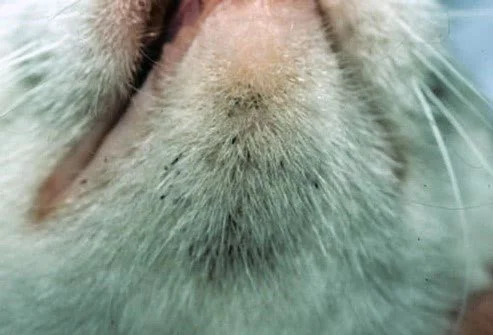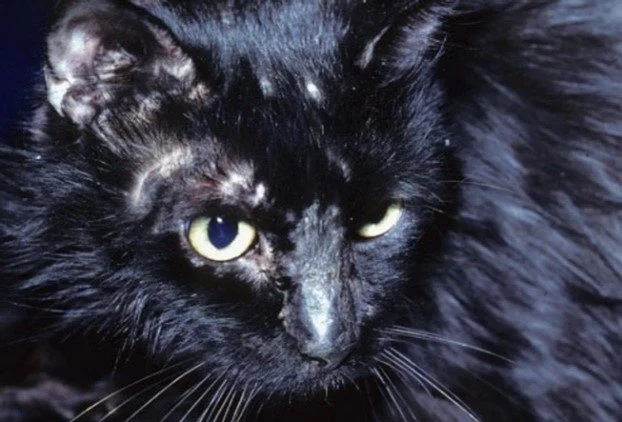Skin diseases in cats
Authored by Hollie Furey
Skin disease in cats is very common and usually we see more cases during the summer months. This article discusses the different types of skin complaints seen in cats and how we, at James Horner Vets, would recommend testing and treating your feline friends.
Common skin complaints in cats:
Feline skin allergies (known as atopy)
Feline Miliary Dermatitis
Feline Acne
Overgrooming
Ringworm
Autoimmune conditions (Feline Eosinophilic Granuloma Complex)
Feline Skin Allergies:
Skin irritation caused by environmental/seasonal allergies are known as atopy. Food allergies and contact allergies are also common. To provide the most suitable treatment for your pet we try to work out what is causing your cat’s allergic flare.
As well as doing a full clinical exam to rule out parasites (fleas/ mites) we need to carry out some diagnostic tests. Common examples of diagnostic tests include skin scrapes or swabs of the affected areas, a food trial, allergy testing (bloods) for environmental/ food allergies and blood work if an underlying health condition is suspected. A skin biopsy may be required to diagnose certain skin conditions.
Feline miliary dermatitis:
Feline miliary dermatitis is an itchy skin rash that is usually an allergic reaction to flea bites! Affected cats commonly spend a lot of time grooming themselves! The most affected areas on the body are usually the lower spine, around the base of the tail, face, ears, neck, flanks, and belly. The fur coat often becomes thin in affected areas.
We can diagnose fleas by brushing your pet’s fur with a flea comb and looking for flea dirt. If we can’t see flea dirt in the coat this does not mean that your pet does not have fleas!! This reaction usually happens because your cat is allergic to the flea’s saliva so it only takes one bite to cause a problem!
We recommend covering your cat for fleas using a veterinary prescription spot-on treatment. In cases where we have seen fleas on your pet we would also advise a good quality environmental flea spray and to wash all bedding on a hot wash, hoover carpets etc.. The flea lifecycle can take up to 3 months to eradicate. Sometimes we also prescribe a steroid anti-inflammatory medication to help make your cat feel more comfortable and to reduce the constant itching in cats that are particularly badly affected and scabby. This can be in the form of a long lasting steroid injection (usually preferable in cats) or tablets.
Feline acne:
Feline acne usually appears on and around a cat's chin. Possible causes include stress, poor grooming, an underlying skin condition, or the plastic bowls you put their food and water in! We advise using ceramic or metal bowls for cats to eat and drink from to prevent feline acne.
Overgrooming
Overgrooming is when a cat grooms itself excessively and produces bald patches! Overgrooming can be caused by stress, boredom, or an underlying health issue that causes pain. For example, arthritic cats sometimes groom painful areas such as their back legs. Cats that overgroom will also experience an increase in hairballs. Overgrooming can look like the cat shown in the image but typically we need to rule out other causes of fur loss first before reaching a diagnosis of overgrooming.
Ringworm:
Ringworm is a type of fungus that affects cats, especially young kittens. It can cause circular lesions on your cat’s head, ears, and front legs as well as any other part of the body. Ringworm is highly contagious and can spread to other pets in the home, as well as to people.
We usually diagnose ringworm by taking fur pluckings and culture these for 21 days at an external laboratory. If your cat is diagnosed with ringworm, treatment depends on the severity of the disease. We usually advise antifungal medication. Some cats benefit from shaving their fur off in extreme cases! It is also very important to treat your home and surfaces with disinfectant. It is important to see your doctor if you notice ringworm lesions on your skin because ringworm is transmissible to humans. For this reason, it is advised to wear gloves when handling a pet diagnosed with ringworm.
Feline Eosinophilic Granuloma Complex:
Different forms of eosinophilic granuloma complex:
Eosinophilic ulcer, or indolent ulcer
If your cat develops ulcers or lesions on their lips, they may be having a type of allergic reaction known as an eosinophilic granuloma.Eosinophilic plaque
These lesions can occur anywhere on the body but are commonly seen on the ventral abdomen (‘tummy’ area). Hair is usually lost from the affected skin and the lesions can be very itchy. Ulceration is common.Diagnosis – a surgical biopsy carried out under general anaesthetic is usually required to diagnose eosinophilic granuloma complex.
Treatment of Eosinophilic granuloma complex lesions:
Glucocorticoids (steroids) are the most common form of management and in lots of cases the itching reduces. The duration and dose of steroids needed will vary between cats, but in some cats lifelong steroid treatment is needed to control the skin disease.
If long-term (or high doses) of steroids are needed, additional or alternative therapies may also be tried to help reduce the dose of steroids needed to help minimise the risk of long-term side effects.
Other treatments include Immunosuppressive drugs such as Ciclosporin, or Cyclosporine (Atopica) which is another drug often used in cats to manage allergic skin disease. It acts as an immunosuppressant and is a good alternative for cats that cannot take steroids.
If you are concerned about your cat’s skin please book an appointment to see us on 0121 270 5800, send us a Whatsapp message on 07568 229686 or book online via our website.






